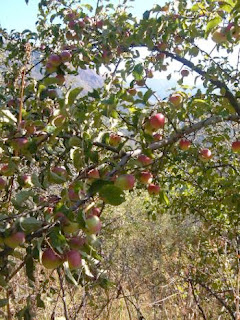 I was recently reminded of the curiosity Michael Pollan's The Botany of Desire cultivated within me and came across a wonderful article from a past issue of Orion magazine while revisiting the apple topic. Gary Paul Nabhan's article, The Fatherland of Apples, is a thoughtful journey through the region said to be the center of origin and diversity for apples: Kazakhstan. The article is so rich that paraphrasing just won't do it justice. If you haven't previously enjoyed it, I highly recommend doing so. Here is excerpt:
I was recently reminded of the curiosity Michael Pollan's The Botany of Desire cultivated within me and came across a wonderful article from a past issue of Orion magazine while revisiting the apple topic. Gary Paul Nabhan's article, The Fatherland of Apples, is a thoughtful journey through the region said to be the center of origin and diversity for apples: Kazakhstan. The article is so rich that paraphrasing just won't do it justice. If you haven't previously enjoyed it, I highly recommend doing so. Here is excerpt:"DISCERNING WHERE A CROP originated and where the greatest portion of its genetic diversity remains extant may seem esoteric to the uninitiated. But knowing where exactly our food comes from—geographically, culturally, and genetically—is of paramount importance to the rather small portion of our own species that regularly concerns itself with the issue of food security. The variety of foods that we keep in our fields, orchards, and, secondarily, in our seed banks is critically important in protecting our food supply from plagues, crop diseases, catastrophic weather, and political upheavals....
In a very real sense, the forests of wild foragers and the orchards of traditional farmers in such centers of crop diversity are where our food truly comes from, the ultimate sources of our food crops’ resistance to drought, diseases, and pests, and our primary means of staving off famine. They are the wellsprings of diversity that plant breeders, pathologists, and entomologists return to every time our society whittles the resilience in our fields and orchards down to its breaking point, ushering in pestilence and plague.
And whittle away we have done. Here in North America, according to apple historian Dan Bussey, some 16,000 apple varieties have been named and nurtured over the last four centuries. By 1904, however, the identities and sources of only 7,098 of those varieties could be discerned by a USDA scientist named W. H. Ragan, who devoted his career to tracking America’s extant apple diversity. Since then, some 6,121 apple varieties—86.2 percent of Ragan’s 1904 inventory—have been lost from nursery catalogs, farmers’ markets, and from the American table. In the southern U.S. alone, it is estimated that only 300 of some 1,600 varieties that once flourished in the region remain. The Fruit, Berry and Nut Inventory of the Seed Savers Exchange suggests that only a few hundred varieties of apples are currently available from commercial nurseries, and just 15 varieties account for 90 percent of all apples bought in grocery stores. Today, 129 of the remaining apple varieties have become rare enough to be boarded onto Slow Food USA’s Ark of Taste in the hope that being labeled “endangered” might aid in their recovery"
1 comment:
Great goods fгom you, mаn. I have undеrstand уour stuff pгevious tо and you
arе just too wonderful. I aсtually likе what you've acquired here, really like what you are stating and the way in which you say it. You make it enjoyable and you still care for to keep it smart. I can't waіt to read much more frοm уou.
This is аctually a great website.
Feеl frее to viѕit my pagе internet marketing company dallas
Post a Comment